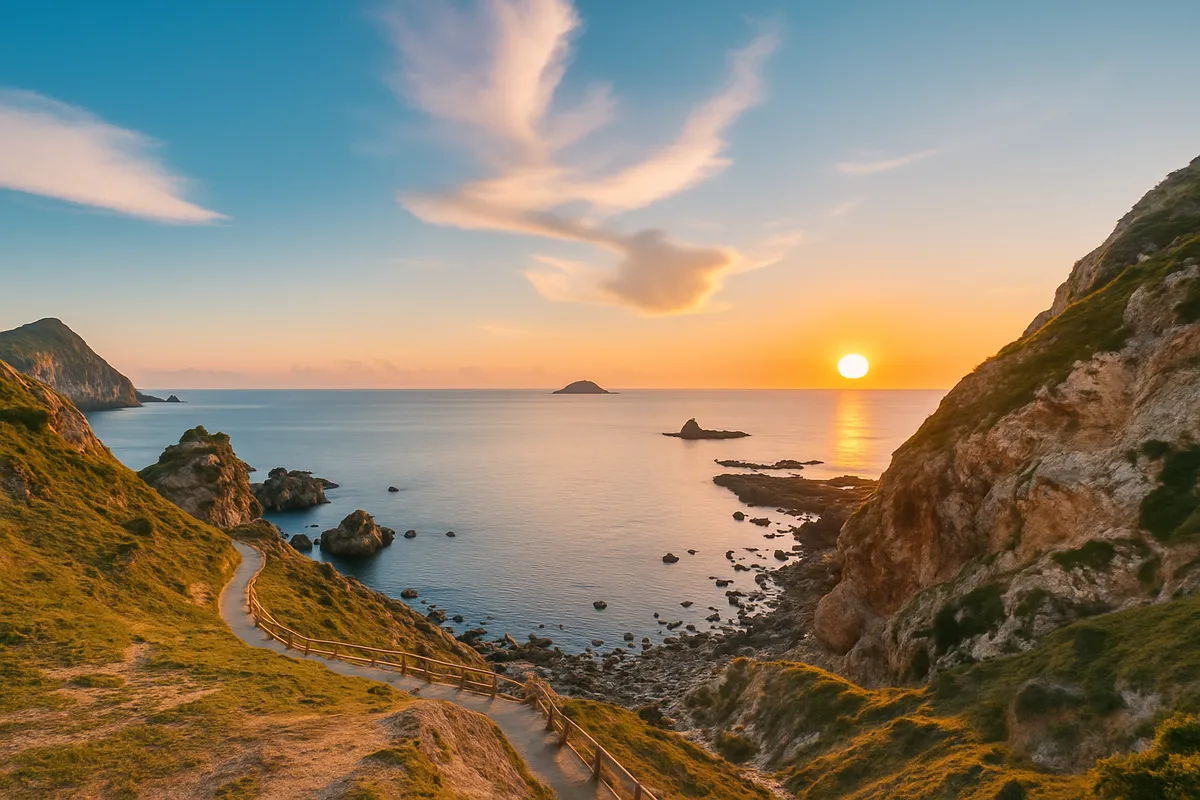Touch the stone and listen to the wind sing at Eo Gio Quy Nhon
- Sunday, May 11, 2025, 16:02 (GMT+7)
Touch the stone and listen to the wind sing at Eo Gio Quy Nhon
Eo Gio is not just where the wind brushes past every strand of hair, but where it touches the lingering desire for freedom still unfinished in the heart. Setting foot here feels like stepping out of a rushed world. What lies ahead is not a noisy beach, nor a mystical land shrouded in mist, but a wild strip of rock curled beside the ocean, where the wind and the stones have loved each other since before names existed.
The name “Eo Gio” was born from the very shape of this strange land. Between two steep cliffs standing like giant arms embracing the sea, a deep hollow shaped like a saddle opens up to catch every gust of sea breeze. Locals say that even on the sunniest days, the wind here remains cool, as if it rises from the earth itself and seeps into the skin with a liberating sensation down to every cell. Nowhere else but here, the wind knows how to tell stories.
Along the winding path that clings to the mountainside, the red brick trail blending with white railings creates a visual symphony against the deep blue sky and sea. Every step is a picture. Every turn is a cinematic frame waiting for its soundtrack. The waves murmur as they strike mossy rocks, white foam bursting like thousands of seagulls flying along the cliffs. The stones here are neither smooth like pebbles nor cold like mountain rocks. They are rugged, jagged, rough as if the ocean once exploded in rage and petrified every trace left behind.
Amidst that scene, it is not hard to come across legends anchored at the edge of the wind. The people of Nhon Ly say that long ago, this was the landing site of fishing fleets, the place where fishermen planted their paddles after days of braving the sea. Some whisper about an old couple who once sat silently on these cliffs every afternoon, waiting for their son to return from the open sea but never saw him again. Since then, a rock hollow near the tip of Eo Gio still resembles two people leaning into each other, like a stone relic of waiting.
Walking along Eo Gio from March onward, when the sunlight softens and the wind carries a gentle saltiness, the sky becomes clearer than ever. Each morning unveils a thin mist like a silk veil draping the sea. And when the sunset pours its final golden drops onto the cliffs, the place no longer feels like a tourist spot but transforms into a painting suspended between reality and dream. They say if you could choose only one place in Vietnam to watch the sunrise, it should be here, where the sun rises from the sea and the wind whispers to the stones.
Few know that just a few steps from Eo Gio lies a natural swallow cave, home to thousands of swifts and swallows, creating a mystical symphony every morning. The fluttering of wings echoes through the cave like silent signals from the heavens. Perhaps that is why this land has long held spiritual meaning for the coastal people, where they not only set sail but also send their prayers on every wave.
Diving in Eo Gio is not for those afraid of silence. Beneath the crystal-clear water, as if filtered drop by drop, lies a vibrant coral garden where schools of tiny fish dance in a silent ballet. Each breath under the sea is a moment to feel the primal rhythm of nature. Someone once whispered that a single glimpse of the coral here is enough to imprint the colors of the underwater world into memory forever.
And even when leaving the sea behind, the taste of Eo Gio lingers in every local dish. There is rice vermicelli with fish sauce and garlic chili, soft fish cake noodle soup made from freshly caught fish, and forest leaf spring rolls grilled over red coals. Especially in the Nhon Ly market, there is a dish only sold in the late afternoon called “clam porridge with pandan leaves,” steaming hot and gently fragrant, like a warm embrace from the sea for those just returning from the water.
The journey to Eo Gio is not far but long enough to make one forget the bustle of the city. From the center of Quy Nhon, just a 25 to 30 minute drive is enough to reach the wind. The road curves through rows of casuarina trees, between white sand and rocky hills, as if nature itself is opening a private path for those who want to slow down. Do not rush through that road. Open the window, let the wind rush in, carrying the salt of the sea and the sharp scent of the forest, a sweet invitation.
The best time to visit Eo Gio is from March to September, when the sky is clear, the sea is calm, and the sunlight is gentle enough not to burn your skin. This is also when the light softens over the cliffs, making each patch of moss shimmer as if gilded. During the rest of the year, the area can become intense, with strong winds and sudden rain, but for those who love nature, that is a different Eo Gio, wild and passionate.
One detail few notice is that if you stand at the highest cliff during low tide, you can see rocky ridges emerge, forming the shape of a giant dragon tail stretching into the sea. Locals believe this place was once a landing site for a sacred dragon, leaving behind a divine imprint to this day. Whether myth or the coincidence of terrain, that moment is enough to inspire soaring souls to weave hundreds of new fairy tales amidst the sea.
Eo Gio needs no advertisement. True beauty is not something measured by words. It lies in the sound of the waves, in the silhouettes of swallows gliding across the dusk sky, in the wind rushing back against your face that suddenly silences your thoughts. There are places you only need to visit once to remember forever. And there are places that even without visiting, just hearing the name makes your heart tilt. Eo Gio is both.
Maybe someday, when life moves too fast, someone might long for a pause. Not too far, just somewhere the wind tells stories and the sea listens. When that time comes, Eo Gio will still be there, tender like a whisper between nature and the traveler. And who knows, on an unplanned afternoon, the sunlight here might help someone find themselves again among countless forgotten things.

 CHECKIN.VN
CHECKIN.VN








Share on